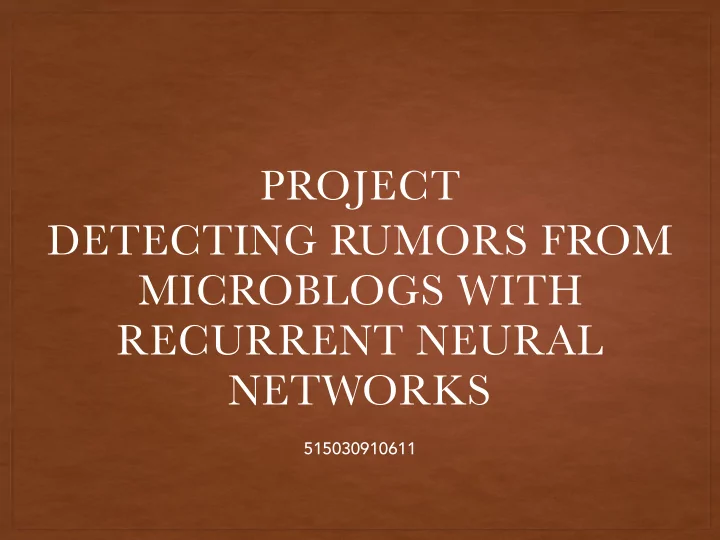

PROJECT DETECTING RUMORS FROM MICROBLOGS WITH RECURRENT NEURAL NETWORKS 515030910611
INTRODUCTION • Microblogging platforms are an ideal place for spreading rumors and automatically debunking rumors is a crucial problem. • False rumors are damaging as they cause public panic and social unrest. • Many incidents of a false rumor highlight that automatically predicting the veracity of information on social media is of high practical value. •
RUMOR REPORTING WEBSITES • disadvantages:for manual verification steps are involved in such efforts, these websites are not comprehensive in their topical coverage and also can have long debunking delay •
EXISTING MODELS DUSING LEARNING ALGORITHM • They incorporate a wide variety of features manually crafted from the content, user characteristics, and diffusion patterns [1][2] of the posts or simply exploited patterns expressed using regular expressions to discover rumors in tweets • Disadvantages: it is painstakingly detailed, biased, and labor- intensive. • [1] Carlos Castillo, Marcelo Mendoza, and Barbara Poblete. Information credibility on twitter. In Proceedings of WWW , 2011. [2] Fan Yang, Yang Liu, Xiaohui Yu, and Min Yang. Automatic detection of rumor on sina weibo. In Proceedings of the ACM SIGKDD Workshop on Mining Data Semantics , 2012. [3] Sejeong Kwon, Meeyoung Cha, Ky- omin Jung, Wei Chen, and Yajun Wang. Prominent fea- tures of rumor propagation in online social media. In Pro- ceedings of ICDM , 2013.
REFERENCE PAPER METHOD ALGORITHM • Main work: Utilizing RNN, it model the social context information of an event as a variable-length time series. They assume people, when exposed to a rumor claim, will forward the claim or comment on it, thus creating a continuous stream of posts. This approach learns both the temporal and textual representations from rumor posts under supervision. •
REFERENCE PAPER METHOD MODEL
REFERENCE PAPER METHOD • In this model, there is a embedding layer that encode the origin representation of words into vector. • However, in this paper, author did’t point out clearly the which is the input. the input is one word or a sentence, if it is one word, then the time step will be the longest length of top k • if it is a sentence, then the time step will be the interval.
MY WORK DATASETS • Using datasets used by the reference paper • After filtration, this dataset includes 4492 effective events and each event includes many post relevant to it.
MY WORK DATA HANDING • For each event, we divide the posts about this event into several continuous intervals and view this as the time steps of this event [4] . • for each interval in event, we split the sentences into word and use tfidf(Salton & McGill, 1983) algorithm to select top-k words during this interval then use these words as the representation of this interval. • [4] MA J, GAO W, MITRA P, ET AL. DETECTING RUMORS FROM MICROBLOGS WITH RECURRENT NEURAL NETWORKS[C]//IJCAI. 2016: 3818-3824.
MY WORK DATA HANDING • for each words , we use a vector to represent it, and the cn_vector set is download from https://github.com/Embedding/Chinese- Word-Vectors in which we select the set trained from Weibo in which each word is represent by a vector of 300 length. • Then we concat these vector of words to represent each interval . So for each events, there are several intervals which means the different time in the sequence.
MY WORK MODEL • for the basic model, we check the reference paper, and construct a basic RNN model. • in this model there are three layers • Mask layer: to complete the time step • RNN layer: for different model, simple RNN, LSTM and GRU layer is selected • full-connected Layer:it output to a sigmoid function and decide the output value.
MY WORK MODEL • I also some complicated model in which I replace the basic RNN layer with the following layer: • multiple layer CNN • CNN with RNN
MY WORK MODEL • CNN with RNN
RESULT
DATA ANALYSIS • For the three RNN-based models, for GRU and LSTM remember more long-term information. GRU and LSTM perform well; GRU is slightly better. Compared to RNNbased model, the CNN- combined model has a slightly better performance.However, the overall performance is still lower than the performance in the reference paper.
Thanks •
Recommend
More recommend